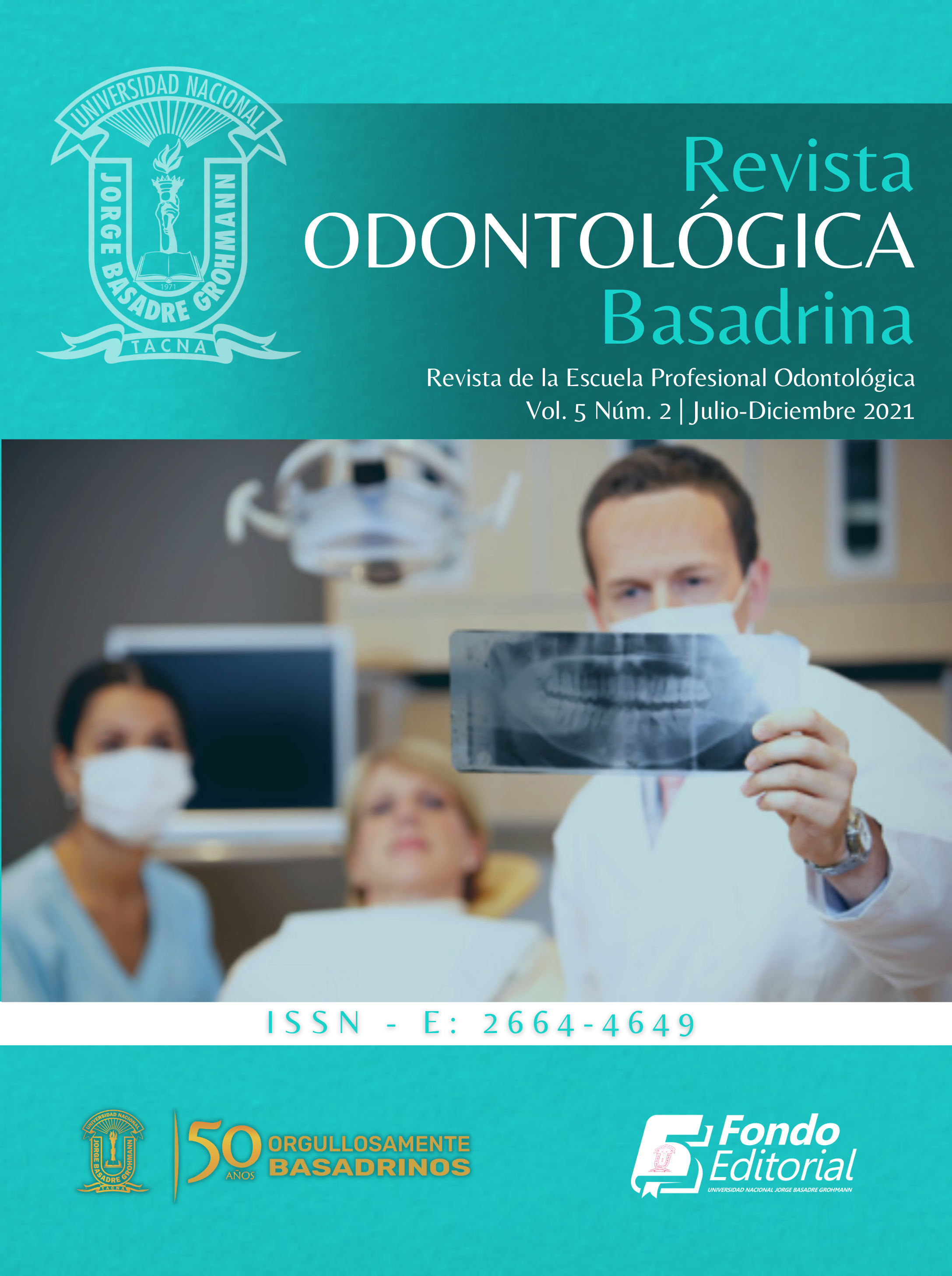Supervivencia de implantes dentales en pacientes con infección por VIH
Main Article Content
Abstract
Objective: To identify the survival rate of dental implants in patients with human immunodeficiency virus (HIV) infection. Material and methods: An electronic search was carried out for observational and experimental studies published up to march 2021 in the PubMed, PubMed Central, Cochrane databases and in the journals about periodontics and implants with a high impact factor according to ISI Web of Science. The assessment of the risk of bias of the observational articles was assessed using the Newcastle-Ottawa scale and the Cochrane manual Version 5.1.0 for clinical trials. Results: 8 observational studies, 2 case reports, 5 case series and 1 cohort study were found, with a follow-up of 1 to 12 years. A total of 1033 dental implants were placed, the CD4+ lymphocyte count presented a mean of 531.48 mm3. The dental implant survival rate in HIV positive patients was 95.31 %. According to the Newcastle Ottawa scale, all included articles showed a low risk of bias. Conclusion: The present systematic review showed a 95.31 % dental implant survival rate in HIV positive patients with a follow-up time of 1 to 12 years.
Downloads
Article Details

This work is licensed under a Creative Commons Attribution 4.0 International License.
References
United Nations AIDS Report. [Internet]. 2019 [citado 16 de abril de 2021]. Disponible en: https://www.unaids.org/es/Homepage
Centro Nacional de Epidemiología, Prevención y Control de Enfermedades. Situación epidemiológica del VIH-Sida en el Perú. febrero de 2020;
Douek DC, Roederer M, Koup RA. Emerging concepts in the immunopathogenesis of AIDS. Annu Rev Med. 2009;60:471-84. DOI: https://doi.org/10.1146/annurev.med.60.041807.123549
Patton LL, Shugars DA, Bonito AJ. A systematic review of complication risks for HIV-positive patients undergoing invasive dental procedures. J Am Dent Assoc 1939. febrero de 2002;133(2):195-203. DOI: https://doi.org/10.14219/jada.archive.2002.0144
Campo J, Cano J, del Romero J, Hernando V, Rodríguez C, Bascones A. Oral complication risks after invasive and non-invasive dental procedures in HIV-positive patients. Oral Dis. enero de 2007;13(1):110-6. DOI: https://doi.org/10.1111/j.1601-0825.2006.01262.x
Moher D, Liberati A, Tetzlaff J, Altman DG, PRISMA Group. Preferred reporting items for systematic reviews and meta-analyses: the PRISMA statement. PLoS Med. 2009;6(7):e1000097. DOI: https://doi.org/10.1371/journal.pmed.1000097
Ottawa Hospital Research Institute [Internet]. 2020 [citado 10 de mayo de 2021]. Disponible en:
http://www.ohri.ca/programs/clinical_epidemiology/oxford.asp
Capparé P, Teté G, Romanos GE, Nagni M, Sannino G, Gherlone EF. The «All-on-four» protocol in HIV-positive patients: A prospective, longitudinal 7-year clinical study. Int J Oral Implantol Berl Ger. 2019;12(4):501-10.
Rubinstein NC, Jacobson Z, McCausland GL, Dibart S. Retrospective study of the success of dental implants placed in HIV-positive patients. Int J Implant Dent. 13 de junio de 2019;5(1):30. DOI: https://doi.org/10.1186/s40729-019-0174-6
Gastaldi G, Vinci R, Francia MC, Bova F, Capparé P. Immediate fixed rehabilitation supported by axial and tilted implants of edentulous jaws: a prospective longitudinal study in HIV-positive patients. J Osseointegration. 29 de junio de 2017;9(2):239-44.
May MC, Andrews PN, Daher S, Reebye UN. Prospective cohort study of dental implant success rate in patients with AIDS. Int J Implant Dent. diciembre de 2016;2(1):20. DOI: https://doi.org/10.1186/s40729-016-0053-3
Gherlone EF, Capparé P, Tecco S, Polizzi E, Pantaleo G, Gastaldi G, et al. A Prospective Longitudinal Study on Implant Prosthetic Rehabilitation in Controlled HIV-Positive Patients with 1-Year Follow-Up: The Role of CD4+ Level, Smoking Habits, and Oral Hygiene. Clin Implant Dent Relat Res. octubre de 2016;18(5):955-64. DOI: https://doi.org/10.1111/cid.12370
Oliveira MA de, Pallos D, Mecca F, Karem López Ortega null, Gallottini M, Andre Luiz Costa null, et al. Dental implants in patients seropositive for HIV: A 12-year follow-up study. J Am Dent Assoc 1939. noviembre de 2020;151(11):863-9. DOI: https://doi.org/10.1016/j.adaj.2020.07.026
Gay-Escoda C, Pérez-Álvarez D, Camps-Font O, Figueiredo R. Long-term outcomes of oral rehabilitation with dental implants in HIV-positive patients: A retrospective case series. Med Oral Patol Oral Cirugia Bucal. 1 de mayo de 2016;21(3):e385-391. DOI: https://doi.org/10.4317/medoral.21028
Sabbah A, Hicks J, MacNeill B, Arbona A, Aguilera A, Liu Q, et al. A retrospective analysis of dental implant survival in HIV patients. J Clin Periodontol. marzo de 2019;46(3):363-72. DOI: https://doi.org/10.1111/jcpe.13077
Manterola C, Otzen T. Estudios Observacionales: Los Diseños Utilizados con Mayor Frecuencia en Investigación Clínica. Int J Morphol. junio de 2014;32(2):634-45. DOI: https://doi.org/10.4067/S0717-95022014000200042
Shoko C, Chikobvu D. A superiority of viral load over CD4 cell count when predicting mortality in HIV patients on therapy. BMC Infect Dis. 15 de febrero de 2019;19(1):169. DOI: https://doi.org/10.1186/s12879-019-3781-1
Oliveira MA, Gallottini M, Pallos D, Maluf PSZ, Jablonka F, Ortega KL. The success of endosseous implants in human immunodeficiency virus-positive patients receiving antiretroviral therapy: a pilot study. J Am Dent Assoc 1939. septiembre de 2011;142(9):1010-6. DOI: https://doi.org/10.14219/jada.archive.2011.0320
Albrektsson T, Zarb G, Worthington P, Eriksson AR. The long-term efficacy of currently used dental implants: a review and proposed criteria of success. Int J Oral Maxillofac Implants. 1986;1(1):11-25.
Hämmerle CH, Brägger U, Bürgin W, Lang NP. The effect of subcrestal placement of the polished surface of ITI implants on marginal soft and hard tissues. Clin Oral Implants Res. junio de 1996;7(2):111-9. DOI: https://doi.org/10.1034/j.1600-0501.1996.070204.x
Sgolastra F, Petrucci A, Severino M, Gatto R, Monaco A. Periodontitis, implant loss and peri-implantitis. A meta-analysis. Clin Oral Implants Res. abril de 2015;26(4):8-16. DOI: https://doi.org/10.1111/clr.12319
